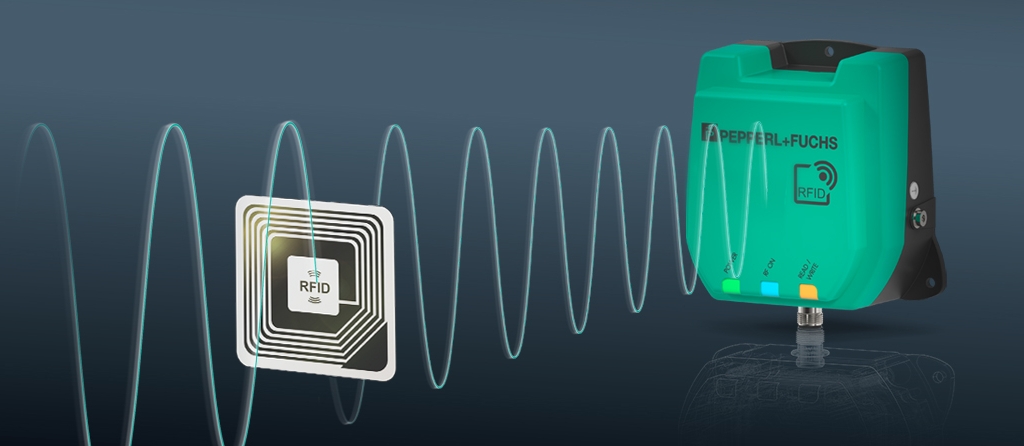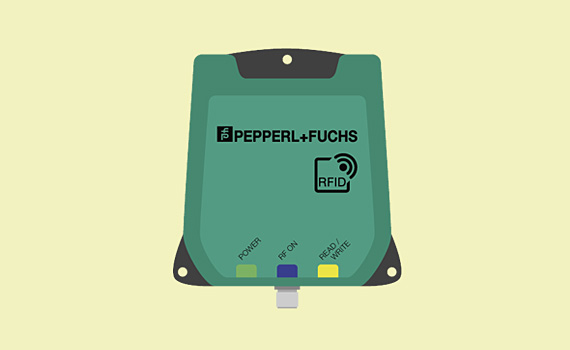Frequently Asked Questions (FAQ) on RFID (Part 2): RFID Readers
Content of This Article
Frequently Asked Questions (FAQ) on RFID (Part 2): RFID Readers
1. What is an RFID reader?
An RFID reader is an active device that uses radio waves to read information stored on an RFID transponder without contact. Most of these reader units are additionally capable of writing to these transponders. An RFID reader usually contains a microprocessor or a digital signal processor. It also has an internal or external antenna
antenna, which retrieves the information from the RFID transponder. The RFID reader then passes this data to a communication unit, which in turn transmits the information to an external host system via common industrial interfaces and protocols (PROFIBUS, MODBUS, PROFINET, Ethernet, serial …). Here, the interpretation of larger data volumes or the targeted search for specific tagged objects is then possible. Host systems are usually warehouse management systems, production planning systems or enterprise resource planning systems.
2. What are the different types of RFID readers?
RFID readers do not have a typical, standardized design, but are available in different variants for a wide range of industries and applications. Accordingly, there are many ways to categorize them: Range, frequency, protocol types, power supply … but the all-important distinction is between stationary and mobile RFID readers.
In industrial applications, stationary readers are permanently placed at specific locations in a plant or factory to detect or identify goods. In access control applications, for example, they are mounted near a security door and grant workers access via their personal RFID transponder. In both cases, stationary RFID readers communicate directly with an external host system.
Mobile RFID readers (also known as “RFID handheld readers”) provide similar functionality, but are distinguished from stationary readers by having a more compact design similar to a cell phone and not requiring a permanent power connection. Data is temporarily stored on the handheld readers and only later transferred to a host system. This is done either via Wi-Fi or by plugging the handheld reader into a docking station. An RFID handheld reader of this type is particularly suitable, for example, for employees who have to quickly record goods on pallets in a delivery area.
3. What is reader collision and how do you avoid it?
The term “reader collision” refers to the possible overlapping of the detection range of RFID readers installed in spatial proximity to each other. In particular, earlier generations of UHF read/write heads were affected by this. In the meantime, reader collision is no longer a real challenge: modern UHF read/write heads, such as those produced by Pepperl+Fuchs, are equipped with so-called frequency hopping or a “Dense Reader Mode”, which prevents UHF readers from influencing each other. Here, the readers use a specific frequency range within which they constantly change channels. Another and more “conservative” variant to avoid reader collision is the use of shielding.
4. How does antenna polarization affect the performance of a UHF RFID reader?
The polarization of the radio waves emitted by a UHF RFID reader is crucial for the reliable identification of objects. In RFID, there are three main types of polarization: linear-vertical, linear-horizontal and circular polarization. In the case of linear-vertical and linear-horizontal polarization, the direction of the vector of the magnetic field component is constant. Other RFID readers use circular polarization, in which the electromagnetic field is emitted in a shape similar to a corkscrew. To achieve the maximum read range of a UHF system, the polarization of the reader must match the polarization of the transponder. Typically, RFID transponder antennas use linear polarization. In simple terms, linearly polarized antennas achieve a greater read range than circularly polarized antennas at identical amplification power (assuming correct alignment of the antennas). Conversely, circularly polarized antennas are better suited for reading transponders with deviating positioning.
The latest RFID readers, such as the F190 and F192 UHF RFID read/write heads from Pepperl+Fuchs, use different polarization types to ensure the most reliable identification. In applications where the transponder orientation is known or does not change, simple linear polarization is sufficient: the orientation of the antenna polarization is set to the RFID transponder, and the signal amplification and power consumption are controlled with pinpoint accuracy. However, if the position of the transponder is unknown or varies, these technically advanced UHF read/write heads can automatically switch between vertical and horizontal linear polarization. This guarantees reliable identification independent of the transponder orientation. This is particularly useful when detecting unsorted, loose goods of all kinds.
5. Which RFID reader is right for my application?
Choosing the right RFID reader for a particular application depends on several considerations. As mentioned previously, the antenna polarization of the reader is an important factor that has an impact in practice. In addition, other aspects are also relevant: Constrained installation space in plants and factories calls for RFID readers in extremely compact designs. What types of housings does an RFID equipment supplier offer? How durable and resistant is the RFID reader? Will it possibly even be used in hygienic areas or exposed to high temperatures? Is the identification solution to be rolled out on a global basis? In this case, it is advantageous if a supplier can offer a specific reader type in several versions for different frequency ranges.
More Expertise on RFID!

Visit our “RFID Hub”! On this special website, we have collected further FAQs, application examples and videos for you on the topic of RFID in automation. If you have any questions, our experts look forward to your inquiry at any time.
More Information
Subscribe to our newsletter and receive regular news and interesting facts from the world of automation.
